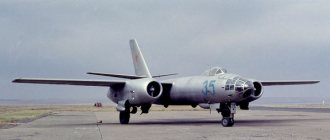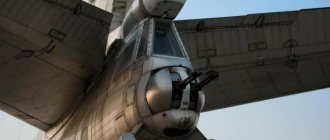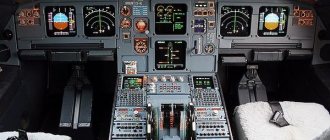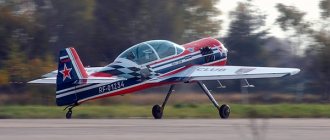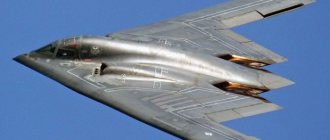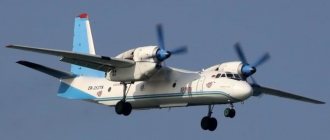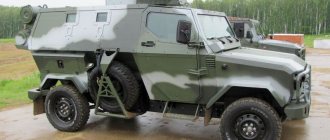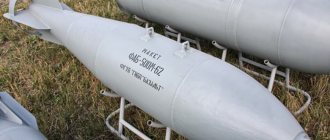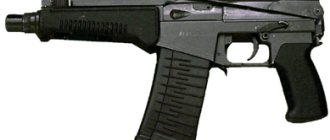Every aviation design bureau has projects that bring them a sense of superiority over themselves. This is precisely the brainchild of the An-124 for the workers of the Antonov design bureau.
The world-famous “Ruslan” once made a splash among heavy transport workers. The still unsurpassed and unique An-124 aircraft continues to win the hearts of all aviation enthusiasts. Despite the fact that the Ukrainians were able to create many other excellent models, it was the Ruslan that remained apart due to the lack of similar developments among other aircraft giants in the world.
General information
Today, the An-124 Ruslan is the largest mass-produced transport vehicle. This transport aircraft has no analogues in its overall dimensions. Moreover, the An-124 aircraft is the world record holder in terms of tonnage and total kilometers of the flight route.
The initial purpose for creating such a “baby” was to perform tasks related to military needs. After all, its development took place just during the development of the Cold War. The An-124 Ruslan heavy long-range transport aircraft is a real product of the confrontation between the Soviet Union and the United States. In general, the struggle for the most part consisted of an aviation race - who would build the best flying machine, who would build the best logical chain for designing the latest equipment, and so on.
War does not mean running at the ready with a Kalashnikov, but it does mean that at any moment one must be ready to attack or defend, and the supply of the military must occur in the shortest possible time. And even taking into account the fact that cargo delivery by sea or rail was always much cheaper, the development of military transport aviation came first.
Ideas about a new transport aircraft
After the release of the largest turboprop aircraft, the An-22, in 1965, the Americans entered into competition with their Lockheed C-5 Galaxy project, which ultimately turned out to be much more powerful than the triumphant Soviet air transport aircraft. Then the leadership of the CPSU Central Committee set the designers the task of creating a machine whose carrying capacity should be about one hundred and forty tons. This acceleration of events was primarily associated with the prestige of the state, and secondly, with the development of an optimal functional aircraft for the speed of deployment of the army and its supply.
The Ukrainians immediately joined the project, since they already had the necessary developments. However, the task assigned to them was also somewhat extraordinary, because no one had ever designed such machines. Therefore, many technical issues were solved literally from scratch, for example, developing equipment or working with aircraft parts and assemblies of incredible sizes for that time.
By 1971, the Antonov Design Bureau already had drawings of as many as two An-124 Ruslan aircraft, according to which modifications with four and six engines were presented. The carrying capacity of the first model was one hundred and twenty tons, and the second - one hundred and forty. In 1973, according to the drawn drawings, a real model was created in real size, and these dimensions amazed all spectators, however, in order to begin serial production, it was necessary to improve absolutely all the characteristics of the aircraft.
History of creation
As a result, to improve the aerodynamic properties of the An-124 Ruslan aircraft, a special group of engineers was organized, and they also worked on improving its strength and safety. In addition, a possible change in materials was assumed when creating ships of this type. The best specialists from the most developed Soviet scientific centers participated in the production of the An-124, so it was born as the crown of the USSR’s design intelligence. At that time, there were no similar technologies in the whole world, because of this the aircraft was endowed with completely unique characteristics.
The An-124 was put into operation in 1982. On December 24, the first flight of the experimental model took place, and three years later it was first presented to the Soviet media, and then the presence of a transport whale was reported at the aviation exhibition held in Paris.
Presentation
In June 1967, the size of the An-22 and its capabilities were assessed at the next air show in Paris. Model No. 01-03 did not participate in demonstrations, but performed several flights to deliver communications, including the Vostok spacecraft. Soon “Antey” was officially presented in the USSR.
Three serial modifications demonstrated the landing of army equipment in July of the same year. This happened at Domodedovo airport (Moscow region). The event was timed to coincide with the 50th anniversary of the October Revolution. And in October, the crew of the vehicle, led by commander Davydov, again surprised the world. The aircraft lifted a load weighing 100.444 tons to a height of 7.848 km.
To carry out the loading, special concrete blocks weighing up to 12 tons were made. Even today, the number of unsurpassed world records of “Anthea” reaches four dozen. Twelve of these achievements were established under the leadership of Marina Popovic.
Life after the collapse of the USSR
After the collapse of the Union, the An-124 Ruslan, as expected, ceased production in Ukraine due to the financial depression. And the last aircraft rolled off the assembly line of the Ulyanovsk aircraft plant in 1995, but the model was slightly modified. Three years earlier, the aircraft had been converted, removing all the equipment used by the airborne troops. Inside, the radio navigation system was changed, and the An-124 pilot's cockpit was replenished with instruments with English inscriptions.
In addition, the cargo compartment has been changed. The engines originally installed on the An-124 were modernized, since they often received complaints due to malfunctions in their operation. But given the sufficient number of aircraft on the aviation market, they did not see further production, despite multiple attempts to resume production, because at the moment the world market is interested in a similar model of air transport aircraft. True, the cost of the An-124 is far from low and amounts to about one hundred million dollars.
Aircraft characteristics
The aircraft was created according to the classic Antonov design: its wings are located quite high to the top of the fuselage, and two engines are attached to the pylons on each side. The crew of the An-124 is located in the cabin, located, as usual, in the bow, with one amendment - the plane inside has two decks, and the lower one is used exclusively for transporting cargo, and the upper one is used specifically for the work of the flight crew.
Also on the second deck there are places for people who accompany the cargo, they are called flight operators, and for additional flight crew, if the working hours of the main one do not comply with the documents established by law. Eighteen seats are provided for them. The cargo compartment is divided into two sealed hatches. In fact, they are the design feature of the machine. There is loading equipment inside the compartment, and the floor is made of titanium material and can withstand the heaviest loads.
The aircraft's landing gear consists of twenty-four wheels, it has several struts, and, despite its size, the An-124 can even land on unpaved runways. Also, using the landing gear, it is possible to change the aircraft's ground clearance and angle of inclination, thus lowering the nose, which makes loading work easier. The chassis has a unique strut rotation system and a sag function.
The front cargo hatch opens automatically using a special remote control: first, the “bow” locks are released, then the bow itself is lifted. At the same time, auxiliary supports are installed, and the aircraft squats due to the front struts rolling forward. The ramp located under the bow also opens, and the pressure trap is laid out on it.
The cargo compartment can accommodate four Mi-8 helicopters, an entire train car used in the subway, or an SSD-100 (“Superjet”) aircraft with its wings and tail removed. And the most amazing thing is that the An-124 Ruslan can transport the Angara launch vehicle.
Staff: eight people. The crew includes: one aircraft commander, his assistant co-pilot, a navigator, two flight engineers (one senior, the other specializing in aviation equipment), one flight radio operator and two operators involved in loading and unloading. The aircraft is controlled using a steering wheel, which has a booster characteristic. This means that the steering wheel can only be tilted using hydraulics, and if it fails, it will no longer be possible to control it manually. It is for this purpose that the machine system uses 4-fold redundancy. Absolutely all control mechanics include rigid cables and rods.
The powerful Ruslan is the first Soviet car to use automation. She checks absolutely all the internal workings of the An-124. Moreover, the devices can automatically determine the weight of the board and report a critical overload mode. The aircraft is equipped with its own personal tractor, which is carried on each flight and is used for towing.
Features and Features
The aircraft has the ability to:
- transportation of general purpose cargo (large, heavy, long) with a total weight of up to 250 tons;
- intracontinental non-stop transportation of cargo weighing 180-200 tons;
- intercontinental transportation of goods weighing up to 150 tons;
- transportation of heavy, large-sized monocargoes weighing up to 200 tons externally on the fuselage;
- the aircraft is the basis for the creation of aerospace systems (project).
The aircraft has a spacious cargo cabin, which allows you to transport various cargoes inside the fuselage, for example:
- 16 ten-ton universal aviation containers UAK-10;
- 50 cars;
- monocargoes weighing up to 200 tons (turbines, generators, BelAZ, Komatsu, Euclid, etc.).
Technical features
The technical characteristics of the An-124 “Ruslan” are quite impressive. Thus, the wingspan is as much as 73.3 meters (the width of Red Square is close to this figure). The length of the entire building is 69 meters, and the height is almost 21 meters (this is a seven-story building).
The carrying capacity of the An-124 varies depending on the category: the normal take-off weight is 392 thousand kilograms, and the maximum take-off weight is 405 thousand kilograms. The empty weight of the plane is much less - 173 thousand kilograms. It follows that the maximum acceptance tonnage is 232 thousand kilograms, or 232 tons. This is an unimaginable number! However, the payload is considered to be 120 -150 tons.
The aircraft is equipped with four D-18T engines. The thrust of each engine at takeoff mode is more than 23 tons, that is, the total mass will result in 12,500 horsepower. Refilling fuel tanks can take half an hour or a whole day. The number of refueling vehicles sometimes reaches forty. The maximum weight of fuel to be filled is 212 tons, while the fuel consumption on the An-124 when loaded to capacity is 12 tons per hour, but until the echelon is occupied - 17 tons per hour. Refueling occurs through four necks. They are located on the main landing gear in the nacelles, and there are two additional ones at the top of the wing on the left and right sides.
The maximum speed that Ruslan develops is 865 km per hour, and the cruising speed is slightly less - 750 km per hour. The distance covered with a load is 4,500 km, and the ferry distance is 16,500 km. In general, in all its characteristics, “Ruslan” is second only to the only copy of the brainchild of the Antonov design bureau - the An-225, or “Mriya”. Unlike the An-124, the An-225's payload capacity is 225 tons, and the length of the cargo compartment is only ten meters longer than that of its younger brother. But the fact is that the Mriya was created in a single copy, it is a special-purpose aircraft, and the Ruslan was assembled at two factories in the amount of 56 pieces.
Il-76MD-90A
(Izdeliye-476) - a deep modernization of the Il-76 aircraft. Built by Ulyanovsk Aviation, part of the UAC.
Cargo compartment dimensions
- Length 24.54 m
- Width 3.45 m
- Height 3.4 m
- Load capacity 60 tons
- Volume 321 m³
Flight characteristics
- Cruising speed 780-850 km/h
- Minimum 220 km/h
- Flight range with a load of 60 tons 4000 km
- with a load of 48 t 5500 km
- with a load of 40 t 6500 km
Specifications
- Length 46.6m
- Wingspan 50.5 m
- Maximum take-off weight 210 t
- Empty weight 88500 kg[25]
- Fuel volume 109,000 l
- Crew 5 people
Available modifications
There are four modifications of the An-124 aircraft in total:
- Basic option.
- Civil version (An-124-100).
- An improved civilian model with additions to the avionics system and an increase in payload weight to one hundred and fifty tons (An-124-100M). Still in use today.
- An improved model requiring three flight crew members (An-124-102).
The aircraft was first used for cargo transportation in 1985 when delivering a mining dump truck to the city of Polyarny from Vladivostok. The car weighed 152 tons, so the process took place in two flights with refueling.
An-124 Ruslan aircraft
An-124 Home / Contents / Your famous namesakes / Names / Patronymics / First name and patronymic / Horoscopes / Tests / Signs
An-124 Ruslan aircraft
- heavy long-range military transport aircraft. English name: AN-124 Ruslan. IATA: A4F. ICAO rus: A124.
Manufacturer: OKB O.K. Antonov.
Country: Ukraine[en].
Category: Civil, Cargo.
The An-124 aircraft is designed for long-range delivery of troops, military equipment and weapons from deep behind the lines to theaters of military operations, transportation of large cargo and heavy economic cargo anywhere in the world[en].
The aircraft is made according to the usual high-wing design for heavy military transport aircraft with a swept wing of a relatively large aspect ratio, a single-tail tail unit and a multi-wheel retractable landing gear. Composite materials are widely used in aircraft. The floor is made of titanium alloy.
The multi-rack landing gear, equipped with 24 wheels, allows the aircraft to be used from unpaved runways, as well as to change the parking clearance and the angle of the fuselage, which facilitates loading and unloading operations.
5000 kg of the airframe structure (1500 m2 of skin) was made from CM, which made it possible to reduce the empty weight of the aircraft by 2 tons. When creating the Ruslan aircraft, a wing with a relatively thick swept supercritical profile was used, which, combined with careful development of the fuselage shape, resulted in high aerodynamic qualities and, consequently, a long flight range.
The fuselage of the aircraft is divided into two decks and, in the interests of ease of maintenance, repair and increase in service life, is divided into a number of sealed compartments for specialized purposes: a cargo compartment to accommodate transported equipment and cargo, an upper front deck to accommodate the main and replacement crews (7 people each) and equipment, upper rear deck to accommodate people accompanying equipment and cargo (80 people). The pressurization of the cargo compartment ensures a pressure drop of at least 25 kPa. This allows passengers to be transported at an altitude of 8,000 meters without oxygen equipment.
Thanks to the presence of front (folding bow) and rear cargo hatches, it is possible to quickly load and unload non-standard cargo from both directions. The sealed cargo compartment (length 36.5 m, without ramp - 26.5 m, width 6.4 m, height 4.4 m) ensures the transportation of cargo with a total weight of up to 120 tons, parachute landing of cargo with a total weight of up to 100 tons on platforms, as well as specially prepared cargo and equipment that excludes the use of platforms. The volume of the cargo compartment exceeds 1000 m3.
The floor of the cargo compartment, made of titanium alloy, allows loading of all types of self-propelled and non-self-propelled wheeled and tracked vehicles with an axle load of up to 12 tons when placed in one row and up to 10 tons when placed in two rows. The cabin is equipped with two onboard loading cranes with a lifting capacity of 10 (20) tons and mobile floor electric winches with a traction force of up to 4.5 tons each. The roller equipment available on the aircraft allows loading and unloading monocargoes weighing up to 50 tons.
The multi-wheeled chassis is equipped with a squatting system, which significantly reduces the inclination of ramps and facilitates the process of loading and unloading equipment and cargo. Each main landing gear consists of five independent two-wheel struts, the front landing gear consists of two struts, each with two wheels. The nose strut steering control system helps turn the aircraft on runways up to 50 meters wide using the asymmetry of engine thrust. To fully utilize its combat capabilities, the An-124 must be operated from concrete runways more than 3,000 m long. However, despite its large size and weight, the aircraft is also capable of flying from unpaved runways.
The power plant consists of four high-bypass turbofan engines D-18T designed by Vladimir Alekseevich Lotarev. In addition to enormous power (23,400 kgf), these engines are characterized by low weight, low fuel consumption and low noise levels. The maximum fuel mass, limited by the aircraft's take-off weight, is 213,740 kg. Having a payload capacity and flight range 2-3 times greater than the An-22 and Il-76, the Ruslan consumes 2.5-3 times less fuel per 1 ton-kilometer of transported cargo. The flight range of the An-124 with a maximum load of 120 tons is 5,600 km, and with a load of 40 tons is 11,000 km, and in this indicator it surpasses the American heavy military-technical vehicle C-5B Galaxy.
The aircraft is equipped with an automatic thrust control system, an automated steering control system, a four-channel hydraulic system, and highly reliable power supply and crew life support systems. In total, 34 computers are involved in the aircraft control systems.
The vessel is also equipped with a navigation radar, an inertial system of increased reliability, a PNPK-124 flight and navigation sighting system, an automated radio communication system TIP-15, and “Loran” and “Omega” radio navigation equipment.
The aircraft returned the USSR[en] leadership in heavy transport aviation, depriving the Lockheed C-5 Galaxy of the title of the largest aircraft in the world. In 1985, the An-124 “Ruslan” aircraft set 21 world records, including those for load capacity (171,219 kg at an altitude of 10,750 m), and on May 6, 1987, a world record for flight range along a closed route was set (20,150.92 km ).
The airliner's first flight took place on December 26, 1982. Deliveries began in 1987.
Aircraft modifications
An-124-100. An-124-100 aircraft for commercial cargo transportation.
The An-124A is a modification under development that has improved flight characteristics, which will ensure its operation from 2nd class airfields.
An-124-200/210. In 1999, the ASTC named after aircraft designer Oleg Konstantinovich Antonov, the Russian JSC Aviastar and the English air transport company Air Foyle prepared and submitted a joint proposal to lease to the UK Ministry of Defense[en] a new version of the Ruslan - the An-124-210 aircraft, equipped engines RB211-524N-T (thrust 264 kN).
Engines: 4 turbojet engines D-18T or RB-211-524N-T
Dimensions and parameters of AN-124
Wingspan: 73.3 m Aircraft length: 69.1 m Aircraft height: 20.8 m Wing area: 628.5 sq.m Number of seats: Crew: 4-6 people depending on modification. Accompanying persons: up to 88 people
Masses and loads
Maximum take-off weight: 405,000 kg Normal take-off weight: 205,000 kg Empty weight: 180,000 kg Maximum fuel weight: 230 tons.
Flight data
Maximum speed: 865 km/h Cruising speed: 800 km/h Ferry range: 16500 km Range: 5000 km Flight range with fuel reserves: - with a load of 120 tons: 4800 km; — with a load of 40 tons: 12,000 km; — distillation: 15,700 km; Service ceiling: 12000 m Take-off run length at normal take-off weight: 2520 m.
The prototype "Ruslan" (USSR 82002, No. 318) made its first flight on December 21, 1982 in Kyiv. The vehicle was lifted by a crew consisting of test pilots V.I. Tersky (ship commander) and A.V. Galunenko, flight engineers A.M. Shuleschenko and V.M. Vorotnikov, navigator A.P. Poddubny, flight radio operator M.A. Tupchienko, leading testing engineers M.G. Kharchenko and BC Mikhailova.
Serial production of the aircraft was launched at KiAPO and the Ulyanovsk AIC of Aviastar JSC.
In 1985, the Liner was first demonstrated at the Paris Air Show. Aeroflot began operating the aircraft in early 1986. He worked primarily for airlines in Siberia, transporting unusually large cargo for industrial gas and oil development. The aircraft entered service with the USSR VTA in January 1987. As of early 1998, 54 flightable examples and one airframe for static testing had been built.
For military transport, the aircraft was used during combat operations in Afghanistan and in the Persian Gulf region (for transporting the Patriot anti-aircraft missile system).
During the Gulf crisis in September 1990, an An-124 aircraft carried 451 refugees from Amman to Dhaka on a single flight (the aircraft was retrofitted with chemically regenerated toilet blocks, a 570-liter drinking water tank, and a sponge rubber cabin covering to accommodate passengers in a recumbent position).
On December 6, 1997, 14-40 hours in the aircraft manufacturing village of Irkutsk-II, an An-124 “Ruslan” of the Russian Air Force crashed. 17 crew members and 6 representatives of the Irkutsk aircraft plant were killed, accompanying the cargo: two Su-27 fighter aircraft destined for Vietnam. The plane fell on a residential village 20-25 seconds after takeoff, exploded and caught fire. A 4-story, 64-apartment residential building was completely destroyed, a boarding school, two residential wooden houses and a three-story school were partially damaged. In total, 72 people died under the rubble of the building and in the fire, including 14 children. Deciphering the “black boxes” showed that, for unknown reasons, the on-board computer malfunctioned: it gave the command to turn off the engines.
"Ruslan" should become the basis for the air launch system of satellites weighing up to 3500 kg, currently being created by the aerospace corporation "Air Launch", for launching into low orbits with a wide inclination range (0-115°). A two-stage missile, placed inside the An-124-VS Ruslan aircraft, is delivered to any point over the ocean or land, where it is landed and then free falls for six seconds, after which the first stage engines are started.
In 2000, after a five-year break, production of the An-124-100 was resumed at Aviastar CJSC (Ulyanovsk). At the end of 2000, one An-124 was sold to Libya, as reported by the head of the Antonov ASTC, Pyotr Balabuev.
| "March of Stalin's Aviation (Aviamarsh)" |
| “We, friends, are birds of passage” [en] - Nikolay Kryuchkov, Vasily Merkuryev, Vasily Neshchiplenko |
An-124-100 An-124-100VS An-124-200/210
Modifications:
The An-124-100 is the most load-bearing serial cargo aircraft. The An-124-100 aircraft for commercial cargo transportation was created and certified in 1992 on the basis of the An-124 military transport aircraft.
An-124-100M. Currently, together with Aviastar JSC, a modification of the An-124-100M aircraft is being created, which uses more advanced domestic (CIS) equipment and equipment from Collins and Litton, which allows reducing the number of crew members to 4 people and increasing flight safety and navigation accuracy.
The engine nacelles are equipped with sound-absorbing elements to ensure compliance with the requirements of Chapter 3 of Annex 16 of the ICAO standards for local noise levels.
An-124A. A further development of the Ruslan could be its new modification - the An-124A, which will have improved flight characteristics, which will ensure its operation from 2nd class airfields.
On December 26, 2013, the An-12, which belonged to the Irkutsk Aviation Plant, crashed while flying from the Novosibirsk to the Irkutsk region. Nine people on board - crew members and aircraft mechanics - were killed. The car was flying from the plant of the Novosibirsk airfield Eltsovka to.
Did you like the article? Like, comment, share with friends! Get +1 to Karma And leave a comment just below. |
| Follow us: |
Find something else interesting:
Have something to say, add, or noticed a mistake? Share! Someday your children[en]-grandchildren will come here and see a familiar name...
Spam, insults, bad language, SEO links, advertising, disrespectful treatment, etc. prohibited. Violators are banned
.
By clicking the “Submit” button in the comment, I agree to the processing of personal data:
Thanks for the tip Privacy Policy | Home | Connection
Operating companies
By 1991, a total of thirty-eight Ruslans were produced according to the state order of the Air Force. Russia got thirty-three of them, which was too many to get the job done, so some of the planes were put into storage. However, the aviation management was well aware of the prospects for entering the international market on a commercial basis, so in August 1990, an aviation organization called Volga-Dnepr was created in Russia, the main shareholders of which were the Ulyanovsk Aviation Industrial Complex named after Ustinov, the Progress design bureau in Zaporozhye and directly the Kiev design bureau named after Antonov itself.
And already in 1991, together with the British, Heavy-Lift Cargo Airlines registered an association. The purpose of creating a joint venture was the international promotion of cargo transportation services on the An-124. Viktor Tolmachev was appointed technical director.
However, after some time, Volga-Dnepr had a competitor in the person of the Ukrainian with the only Mriya. After all, the main customer, Russia, fell off after the collapse of the Union, and the transport business had to be developed.
Among other things, the 224th detachment of the Ministry of Defense and Aeroflot also began to operate the An-124. How many companies in Russia have used it? According to initial estimates, four, excluding the international corporation.
But the most surprising fact about the operation of the Ruslans was the signing of an agreement between the Russian-Ukrainian company and NATO in 2006 in Leipzig. According to the agreement, the alliance received access to twenty Ruslan aircraft, two of which were to be based in Leipzig on a permanent basis.
Initially, the papers were signed for three years with a further extension, which the alliance took full advantage of, since the American model A400M, which was supposed to replace Ukrainian trucks, had not yet been released. NATO used not only the An-124, but also the Mriya, as well as the Il-76. Plus, France also used Ruslans during the operation in Mali (2013).
Today Volga-Dnepr has twelve aircraft and is the world's largest operator of the An-124. Plus, thanks to international cargo transportation, the company can stand on its own two feet, because on average a charter flight costs the employer seven hundred thousand dollars. The geography of flights is replete with diversity: cargo is delivered to 190 countries around the world, to more than 1,300 airports. Every year Volga-Dnepr operates one thousand two hundred flights. Some orders from the space industry are scheduled several years in advance, because not a single aircraft can transport large-scale and oversized cargo, except for the An-124.
An-70 design
The aircraft is a four-engine propeller-fan turboprop high-wing aircraft with a tail cargo hatch and a single-tail tail unit. During testing of the aircraft, the possibility of its use on unpaved runways of about 600 m in length with a load of up to 20 tons was confirmed.
Good performance characteristics are explained primarily by the original power plant, which includes the D-27 engine and the SV-27 propfan. The total power of the power plant used on the An-70 is 14,000 hp. The high degree of air compression in the compressor provides good efficiency in terms of fuel consumption. On average, four engines consume 3.5-4 tons of fuel per flight hour.
Coaxial propellers produce a high-pressure jet of air, which flows around the wing at a speed higher than the speed of the oncoming flow, and this in turn increases the lift of the wing. Extending the flaps (set to 60° in landing mode) creates a rotating effect of the thrust vector.
Based on this, during landing with flaps extended, most of the lifting force is produced due to forceful blowing, and a smaller part is produced by the influence of the oncoming flow.
Among other things, the An-70 has the following advantages:
- Equipped with an “electronic board” system. The cockpit and interior can be easily adapted to virtually any avionics equipment from well-known global manufacturers.
- It has an electronic remote control system, which ensures safe and convenient control of the aircraft. As an example, after one of the engines fails, the system itself can center the aircraft without intervention from the pilot. It is provided with automatic protection against reaching supercritical flight conditions, which include excessive sliding, stalling and steep spiral.
- In a special compartment it is possible to transport military cargo.
An-70 characteristics:
| Modification | An-70 |
| Wingspan, m | 44.06 |
| Aircraft length, m | 40.73 |
| Aircraft height, m | 16.38 |
| Aircraft weight, kg | |
| empty | 73000 |
| normal take-off | 111000 |
| maximum takeoff | 130000 |
| Fuel, kg | 38000 |
| engine's type | 4 TVD Progress D-27 |
| power, kWt | 4 x 14000 |
| Maximum speed, km/h | 890 |
| Cruising speed, km/h | 800 |
| Practical range, km | 7400 |
| Range, km | 1350 |
| Practical ceiling, m | 12000 |
| Crew, people | 3-5 |
| Payload: | 300 soldiers or 206 wounded or up to 47,000 kg of cargo |
Unusual cargo
The company also has its own list of unusual orders. For example, once giant rings weighing fifty tons, intended for gold mining, were transported. But at the moment of loading, the distance between the fuselage and the edge of the ring was only 77 millimeters, and this is a critical point.
In 1989, “Ruslan” transported equipment (140 tons) for the first concert in the USSR of the Pink Floyd group.
In 1992, two hundred thirty million pounds sterling in gold (52 tons) was transported from the UAE to Switzerland.
In 1993, 310 tons of musical equipment and stage accessories were brought to Russia for a Michael Jackson concert. Then three sides were used.
In 1997, from the capital of Great Britain to Tunisia, an An-124 transported one hundred tons of equipment for the filming of the film “Star Wars” in one trip.
And in 1998, sixty-eight animals were transported from Prague to the Indonesian zoo, including a hippopotamus, four giraffes, crocodiles, a zebra and so on.
